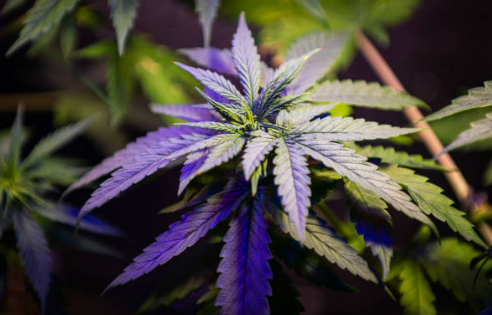Have you noticed purple or red stems on your cannabis plants and wondered if something is wrong? While some strains naturally develop colored stems, other times, it signals an issue that needs attention. Ignoring the warning signs could lead to stunted growth or lower yields. Understanding what is normal and what requires action is key to keeping your plants healthy.
Sometimes, the color change is purely aesthetic, but in other cases, it points to an imbalance in the plant’s environment or nutrient intake. The key is to assess overall plant health and growth patterns to determine if intervention is needed.
This article will help you identify the causes of purple and red stems, from genetic traits to environmental stress, nutrient deficiencies, and pathogens. You will also learn how to address these issues by adjusting pH levels, managing nutrients, and optimizing your growing environment to keep your plants thriving.
Identifying Changes in Cannabis Stem Color
Cannabis stems should be sturdy and vibrant green, but color variations can occur. Some plants naturally develop red or purple hues due to genetics, while others experience discoloration due to stress, deficiencies, or environmental factors. Knowing how to tell the difference can save you from unnecessary adjustments or missed problems.
What to Look For
- Color Changes Over Time: Gradual shifts are often genetic, while sudden discoloration may indicate stress or deficiencies.
- Stem Location: Are the lower, middle, or upper stems affected? Lower stems may indicate root issues, while upper discoloration can be nutrient-related.
- Uniform vs. Patchy Discoloration: Evenly colored stems are likely genetic, while patchy or streaky changes suggest a problem.
- Accompanying Symptoms: Look for wilting, slow growth, curling leaves, or discoloration in foliage, which could indicate deeper issues.
- Stem Texture and Strength: Soft, brittle, or weak stems may signal disease or damage, while firm stems with color shifts are usually not a concern.
- Seasonal or Growth Stage Influence: Colder temperatures and strain genetics can naturally enhance red or purple hues, especially in late flowering.
Observing your plant as a whole rather than focusing only on stem color helps determine if action is necessary. If the plant appears healthy otherwise, the color change is likely harmless.
So, how do you fix purple stems in your cannabis plant? Let us understand.
How to Fix Purple Stems on Weed Plants
If the discoloration is stress-related or due to nutrient imbalances, making a few adjustments can help restore plant health and prevent further issues. Addressing the underlying cause promptly ensures uninterrupted growth, and your plants remain strong and resilient. Here’s what you can do:
- Test and Adjust pH Levels: Cannabis thrives in a pH range of 6.0-6.5 in soil and 5.5-6.0 in hydroponic setups. If the pH is too high or too low, nutrients become unavailable to the plant. Use a pH meter to check the levels regularly and adjust using pH up/down solutions as needed.
- Flush Roots: If you suspect nutrient lockout, flush the growing medium with clean, pH-balanced water to remove excess salts before resuming a properly balanced feeding schedule.
- Optimize the Environment: Keep temperatures stable, avoid drastic humidity fluctuations, and monitor lighting intensity to reduce plant stress. Ensure proper air circulation and maintain a consistent day-night temperature range.
- Provide Balanced Nutrition: Ensure sufficient phosphorus and magnesium levels while avoiding overfeeding, which can lead to toxicity or further imbalances. Use a well-balanced nutrient formula and adjust feedings based on plant growth stage.
- Monitor for Pathogens: Check for signs of fungal or bacterial infections like wilting, lesions, or mold growth. Improve air circulation, maintain proper humidity, and treat affected plants with organic fungicides or beneficial microbes if needed. Tracking these issues over time helps you spot patterns, and PlanaCan makes it easy by letting you generate detailed reports for each harvest. You can see how your cultivation decisions affect yield, analyze trends, and refine your process, all in one organized place.
- Reduce Stress Factors: To prevent unnecessary stress responses, limit excessive handling, avoid drastic changes in watering schedules, and protect plants from extreme temperature shifts.
These are some tips for fixing purple and red steams in your cannabis plan, based on different factors like genetics, stress, or environmental causes. Let’s understand each cause in detail and look for solutions.
Genetic Causes of Cannabis Stem Discoloration
Some cannabis strains naturally develop purple or red stems due to their genetic makeup. This is especially common in Indica-dominant hybrids, which often have deep-colored foliage and display hues of red or purple in their stems as part of their normal growth. Here are some of the causes of genetic discoloration in cannabis stems:
- Inherited Traits: Some cultivars are genetically programmed to develop purple or red stems, which is a natural characteristic rather than a problem.
Solution: If genetics cause red or purple stems, no fix is needed. It’s a natural trait and won’t harm plant health.
- Anthocyanin Pigments: Some strains produce higher amounts of anthocyanins, the pigments responsible for red, purple, and blue hues in plants.
Solution: If the color change is purely due to anthocyanins, it’s not an issue. However, ensuring optimal nutrients and avoiding stress can prevent excessive coloration.
- Cooler Temperatures: Lower temperatures, especially at night, can enhance anthocyanin production, intensifying purple coloration in genetically predisposed strains.
Solution: Keep nighttime temperatures stable and above 65°F (18°C). Using a heater or adjusting ventilation can prevent excessive cooling.
- Lighting Conditions: Certain strains may exhibit more coloration under specific lightings, such as high-intensity LEDs or natural shifts in light exposure.
Solution: If intense LED lighting enhances pigmentation, slightly adjust the light intensity or height. Ensure plants receive the right spectrum for balanced growth.
- Aging and Maturity: Some plants develop deeper pigmentation as they mature, especially during flowering stages when nutrient shifts occur.
Solution: If pigmentation develops naturally with maturity, no fix is necessary. Monitor nutrient levels, especially phosphorus and potassium, to support healthy growth.
- Stress-Responsive Genetics: Some strains develop purple or red stems in response to mild stressors, such as fluctuations in temperature or light exposure, even if they are otherwise healthy.
Solution: Identify and minimize stressors, such as fluctuating temperatures, inconsistent watering, or excessive light. Maintaining a stable environment reduces unnecessary pigmentation.
- Seasonal Changes: Outdoor plants may show more pigmentation changes in response to seasonal shifts, particularly during autumn, when temperatures drop and daylight hours decrease.
Solution: If you grow outdoors, use greenhouses or row covers to regulate temperature changes. For indoor plants, adjust lighting and heating to mimic optimal growing conditions.
If your plant is otherwise thriving and shows no signs of stress, such as slowed growth, drooping leaves, or nutrient deficiencies, the color change is likely a harmless genetic trait rather than a cause for concern.
Tracking plant health over time helps you make better decisions. PlanaCan generates detailed reports for each harvest, organizing all your cultivation data in one place. Reviewing these reports allows you to spot trends, refine your process, and build on what works to boost yields and profitability.
Now, let us discuss the environmental causes of cannabis stem discoloration in detail.
Environmental And Stress-Related Causes of Cannabis Stem Discoloration
Genetics, environmental factors, or stress-related conditions can cause stem discoloration in cannabis. While some strains naturally develop red or purple stems, environmental stressors can negatively impact plant health. Below are the key causes and their solutions.
- Temperature Stress
- Cause: Cold nights or sudden temperature fluctuations can trigger anthocyanin production, leading to purple stems.
- Fix: Keep temperatures stable (above 65°F/18°C) using heaters or adjusting ventilation.
- Light Stress
- Cause: High-intensity LEDs or HPS lights can cause red or purple streaks.
- Fix: Adjust light distance and intensity to prevent overexposure.
- Humidity Fluctuations
- Cause: Inconsistent humidity affects nutrient uptake and pigmentation.
- Fix: Maintain ideal humidity (60-70% for seedlings, 40-50% for flowering) using hygrometers.
- Poor Air Circulation
- Cause: Stagnant air affects transpiration and can lead to discoloration.
- Fix: Improve ventilation with oscillating fans and proper spacing.
- Nutrient Deficiencies
- Cause: Stem discoloration can result from a lack of phosphorus (P), magnesium (Mg), or potassium (K).
- Fix: Conduct soil tests and adjust feeding schedules based on plant needs.
- pH Imbalance
- Cause: Incorrect pH in soil or hydroponics disrupts nutrient absorption.
- Fix: Maintain a pH of 6.0-6.8 in soil and 5.5-6.5 in hydroponic systems.
- Root Stress
- Cause: Overwatering, poor drainage, or root-bound plants restrict oxygen flow, leading to stress.
- Fix: Use well-draining soil and fabric pots, and avoid overwatering.
- Mechanical Stress
- Cause: Bending, topping, or rough handling can cause temporary discoloration.
- Fix: Handle plants gently and allow recovery time after training.
- Pests and Diseases
- Cause: Root aphids, thrips, and fungal infections can weaken plants, causing color changes.
- Fix: Inspect regularly and use organic pest control methods like neem oil.
- Transplant Shock
- Cause: Moving plants to new containers can stress roots, leading to color changes.
- Fix: Minimize shock by watering before transplanting and using mycorrhizal fungi.
- Genetics
- Cause: Some strains naturally develop purple or red stems due to their genetic makeup.
- Fix: No fix needed; ensure optimal growing conditions for overall plant health.
Monitoring humidity levels, improving ventilation, and maintaining consistent watering practices help keep your plants healthy and reduce stress. PlanaCan makes it easier to track these factors by generating detailed reports for each harvest. With all your cultivation data in one place, you can spot trends, see what works, and refine your process for higher yields and better profitability.
So, how do nutritional deficiencies affect the stem color, and how can you fix them? Let us understand.
Cannabis Nutritional Deficiencies and Stem Color
When a cannabis plant lacks essential nutrients, stem color can change as an early warning sign. Recognizing these deficiencies early can help prevent more severe plant health issues. Here’s what to check and how to fix it:
1. Phosphorus Deficiency
- Symptoms: Stems turn reddish-purple, especially on older growth. Leaves may darken or develop necrotic spots.
- Fix: Ensure your plants get enough phosphorus, especially in early veg and bloom. Use a balanced nutrient mix and check pH levels (ideal range: 5.8–6.2 in hydro, 6.0–6.5 in soil).
2. Magnesium Deficiency
- Symptoms: Purple stems along with yellowing or interveinal chlorosis on older leaves.
- Fix: Supplement with Epsom salt (magnesium sulfate) or a cal-mag supplement. Keep pH levels in check, as improper pH can block magnesium absorption.
3. Nitrogen Deficiency
- Symptoms: Lower stems may turn reddish while leaves turn pale green or yellow.
- Fix: Adjust feeding to include a nitrogen-rich fertilizer, especially in veg. Be mindful not to overdo it, as excess nitrogen can cause other issues.
4. Potassium Deficiency
- Symptoms: Stems turn weak and reddish-purple; leaves may show burnt edges.
- Fix: Use a bloom booster or a potassium-rich nutrient. Ensure your soil or medium isn’t absorbing potassium due to excess calcium or sodium.
Pro Tip: Always check your pH levels first before adding nutrients—imbalanced pH is a common cause of nutrient lockout, leading to deficiencies and discoloration. PlanaCan helps you stay on top of pH checks by providing a clear visual timeline for tracking cultivation tasks. You can plan months ahead while managing daily work, adjust tasks as needed, and ensure nothing, like monitoring pH, gets overlooked.
So, which pathogens are responsible for cannabis stem discoloration?
Pathogenic Causes of Cannabis Stem Discoloration
Fungal and bacterial infections can lead to stem discoloration and serious plant health issues if left untreated. Recognizing the signs early and taking action can help prevent disease from spreading and affecting your entire crop. Here’s what to watch for and how to fix it.
1. Fungal Infections
- Fusarium Wilt: A soil-borne fungus that causes reddish streaks on stems, wilting, and plant death.
- Pythium (Root Rot): Primarily a root issue, it weakens stems, making them discolored and fragile.
- Damping-Off Disease: Caused by fungi like Rhizoctonia and Pythium, damping-off makes young stems soft, purple, and prone to collapse.
How To Fix it: Improve drainage, reduce humidity, and introduce beneficial microbes like Trichoderma or mycorrhizal fungi to protect roots.
2. Bacterial Infections
Pseudomonas & Other Bacteria: Some bacteria cause cankers or lesions that turn stems red or purple.
How To Fix it: Remove infected plants, sterilize tools, and increase airflow to reduce moisture buildup.
3. Viral Diseases
Tobacco Mosaic Virus (TMV): Though rare, TMV can cause irregular purple or red streaks on stems and leaves.
How to Fix It: There is no cure, but you can destroy infected plants and disinfect hands and tools to prevent the spread.
4. Phytophthora (Water Mold)
Causes stem lesions, purple discoloration, and sudden wilting, often leading to rapid plant death.
How To Fix it: Improve drainage, avoid overwatering, and treat soil with biofungicides.
5. Pest-Related Infections
- Aphids, Thrips, and Whiteflies: These pests spread bacteria and viruses that lead to red or purple stems.
- Borers and Stem-Dwelling Insects: Some larvae tunnel into stems, weakening them and making plants susceptible to infections.
How To Fix it: Use insecticidal soap, neem oil, or beneficial predators like ladybugs to control pests.
6. Stem Cankers & Necrosis
Various pathogens cause dark red or purple lesions on stems, leading to plant collapse.
How To Fix it: Prune infected areas, apply organic fungicides, and keep a clean growing environment.
Now, in detail below, let us understand how to fix purple stems on weed plants.
Conclusion
Purple or red stems on a cannabis plant can be completely normal or a sign of an underlying issue. Genetic traits, environmental conditions, nutrient deficiencies, and stress all contribute to stem discoloration. The key is to assess the overall health of your plant. The color change is likely harmless if it grows well with strong stems, vibrant leaves, and steady development. However, it is time to take action if you notice stunted growth, drooping leaves, or other stress signals.
Managing a cannabis grow takes time and attention to detail, but the right tools can make it easier. PlanaCan helps you streamline your cultivation process by simplifying task scheduling with automated work templates and an interactive calendar for planning and tracking every growth stage.
With PlanaCan, you can define each step of your workflow from planting to harvest using customizable templates, ensuring consistency and efficiency. It also provides a clear timeline for upcoming tasks, allowing you to adjust schedules and stay on top of daily operations. By improving organization and reducing the risk of missed tasks, PlanaCan helps you focus on maximizing yields and maintaining healthy plants.
Using PlanaCan, you can improve efficiency, reduce mistakes, and focus on producing high-quality cannabis. Schedule a free call today.




